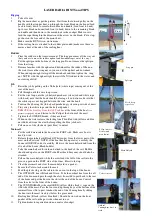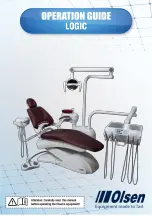
3
ENGLISH
What is Blood Pressure?
Blood Pressure is a measurement of the pressure of the blood flow-
ing against the walls of the arteries. Arterial blood pressure is con-
stantly changing during the course of the cardiac cycle. The highest
pressure in the cycle is called the systolic blood pressure. the lowest
is the diastolic blood pressure ; the both readings are necessary
to enable you to evaluate the status of your blood pressure. Many
factors such as physical activity, anxiety, or the time of day, can in-
fluence your blood pressure, Blood pressure is typically low in the
morning but high from afternoon to evening. It is lower in the summer
but higher in the winter.
What is normal blood pressure?
Blood pressure varies from individual to individual and is dependent
upon a number of factors, such as age, weight, physical condition of
gender. The classic normal reading for an adult between the ages
of 18 and 45 is 120/80. Remember, only your physician is qualified
to determine whether the readings you obtain are normal for you.
How to measure the blood pressure?
1. Relax yourself and adjust to a proper position
• It is very important that the person whose blood pressure is being
taken is relaxed and sitting comfortably.
• Keep arm being measured at heart level. Arm extended but not too
tense or stiff. Rest arm on a flat surface, such as a desk with the
left palm facing upwards. Keep arm being measured still.
2. How to put on the velcro cuffs and chestpiece
• Place the cuff 2-3cm above the bend of the elbow on the naked left
upper arm; Close the cuff by means
of the velcro closure. Cuff should be
snug but not too tight, One or two fin-
gers should fit between cuff and arm.
Never place cuff over article of cloth-
ing
• For cuff with metal D-shaped ring, pull
the free end of the cuff through the
D-ring and close the cuff by means of the
velcro closure.
• In units intended
for home use, the
diaphragm. of the
chestpiece of the
stethoscope inte-
grated into the cuff must be placed above
the brachial artery.
3. Inflating the cuff
• Close the air valve on the bulb by turning the screw
clockwise, Do not over-tighten.
• Squeeze the inflation bulb with the hand you used to
at a steady rate until the needle on the gauge points
30mmHg above your nor-
mal upper systolic-pressure
value. If you don’t know it,
inflate just to 200mmHg.
4. Systolic blood pressure read-
ing-upper value
• Slowly open air valve by
turning screw counter clock-
wise and hold stethoscope
chestpiece over brachial
artery. Proper deflation rate is vital for an accu-
rate reading so you should practice and master
a recommended deflation rate of 2-3mmHg per
second or a drop of one to two marks on the
pressure gauge each heartbeat. You should not
keep the cuff inflated any longer than necessary.
As the cuff begins to deflate, you must listen carefully with the
stethoscope. Note the reading on the gauge as soon as you hear
a faint, rhythmic tapping or thumping sounds. This is the systol-
ic-upper-blood pressure reading. Listen carefully and familiarize
yourself with pulse sound. Once familiar you should check this
procedure with your physician.
5. Diastolic blood pressure reading-lower value
• Allow the pressure to continue dropping at the
same deflation rate . When your diastolic-low-
er-blood pressure value reached, the thump-
ing sound stops.
• Deflate the cuff valve completely. Remove the
cuff from arm and stethoscope from ears.
6. Record your readings
Repeat the measurement two or more times. Do not forget to record
your readings and the time of the day measurement is made imme-
diately after you finish measuring. A convenient time is first thing in
the morning, or just before evening meals. Remember that your phy-
sician is the only person qualified to analyze your blood pressure.
7. Specifications
Measuring and scale range :0-300mmHg
Precision: ±3mmHg
Scale graduation:2mmHg
Maintenance
With proper care and maintenance, your blood pressure kit will pro-
vide years of satisfactory service. The basic rules:
• Do not drop or jar.
• Never inflate beyond 300mmHg.
• Never expose the cuffs to intensive solar radiation!
• Never touch the cuff fabric or parts with a sharp instrument, since
this could cause damage!
• Always deflate cuff completely before storage
• Do not dismantle manometer under any circumstance.
• Store complete instrument in storage case provided, to keep the
chestpiece and all the other parts clean.
• Storage temperature condition: -20°C to 70°C at a relative air hu-
midity between 20% and 85%.
• Operating temperature condition: 10°C to 40°C at a relative air
humidity between 20% and 85%.
• Wipe off the manometer and bulb with a damp cloth Sterilization is
not necessary, since the parts do not come into direct contact with
the patient’s body.
• Remove the bladder first, and wipe the velcro, bladder and tubes
with a damp cloth. The cuff can be washed with soap and cold
water like all the other cuffs,but you must rinse the cuffs with clear
water afterwards and let them air dry.
GIMA WARRANTY TERMS
The Gima 12-month standard B2B warranty applies.
Summary of Contents for 32690
Page 11: ...11 ARABIC 40 10 85 20...






























